Are you a Quiet Speculation member?
If not, now is a perfect time to join up! Our powerful tools, breaking-news analysis, and exclusive Discord channel will make sure you stay up to date and ahead of the curve.
Well, that was fast. Normally we have three full weeks of spoilers, but Wizards has really rushed out Ikoria. I'm guessing the quarantine is a factor here and they're in a bit of a scramble. In any case, the entire set is now out. And it's a little mediocre, Modern-wise. As I mentioned last week, this set is not really meant for us, and that's okay. Not getting format-changing cards every set is a good thing. We've had enough of that over the past year. There are a number of playable cards in Ikoria, Lair of Behemoths, but their impact is going to be more subtle.
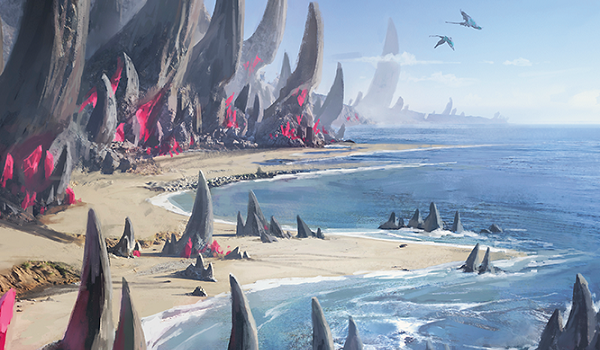
To start off, the overarching thread of this article is that nothing's completely free. Even if there's no up-front cost to something, there will be an opportunity cost. It's why in economics, we teach that there's no such thing as a free lunch. Just because you didn't have to pay for lunch doesn't mean there wasn't some cost attached. In a college context, to get that free pizza, you have to hear a presentation or lecture. Maybe it means paying with a favor down the line. Or getting the free lunch meant giving up another, arguably better, dining option. When a choice is made, it eliminates alternative choices, and the next best option is the opportunity cost. In Magic, every card in your deck has an opportunity cost attached, since it is being chosen over something else. The question is whether the benefit justifies the cost.
Triassic Park
On that note, Ikoria offers manabases a boost with a significant downside. Stand aside, dual lands; Magic has tri lands now. Tricycle, as I think about it, in the same vein as the Amonket bicycle lands. For the first time ever, there are fetchable three-color lands for each  Tarkir shard. Which always come into play tapped, and cycle for three. The only bicycler that has really seen play is Sheltered Thicket thanks to Scapeshift. Given that Modern's manabase has always been built around dual lands which can enter untapped, the bicyclers weren't needed. The tricycles are another story. There's never been a way to fetchably fix three-color mana.
Tarkir shard. Which always come into play tapped, and cycle for three. The only bicycler that has really seen play is Sheltered Thicket thanks to Scapeshift. Given that Modern's manabase has always been built around dual lands which can enter untapped, the bicyclers weren't needed. The tricycles are another story. There's never been a way to fetchably fix three-color mana.
The cost of coming into play tapped is a steep one, but mostly in the mid-game. Control decks don't often do anything turn one, so fetching a tapped land is common. Late-game, the mana is likely to be unnecessary, so the cycling option comes into play. It's in the mid-game when control is being established that tapped lands and tempo matter. Thus, I don't think any tricyclers are going to be four-ofs, but as a one- or two-of, they're extremely potent. For a Tarkir-shard midrange or control deck, their tricycle land is the best first land available.
Brittle Crust
Which is rather timely, considering that UGx midrange is kind of a big deal at the moment. There are many flavors, but for this discussion, the only relevant ones are Sultai and Temur Snow. Both get a tricycler, and so get the boost. Sultai snow has never really been a deck, while Temur variants are everywhere, which would suggest that Ketria Triome will see a lot of play.  I don't think that will actually happen. The play patterns of the snow decks don't play to the Triome's strength. Snow decks tend to fetch basics early to play Arcum's Astrolabe and turn on Ice-Fang Coatl. I don't think it's optimal or necessary to break up this pattern for Ketria's sake, which pushes it towards the mid-game, where it's at its worst.
I don't think that will actually happen. The play patterns of the snow decks don't play to the Triome's strength. Snow decks tend to fetch basics early to play Arcum's Astrolabe and turn on Ice-Fang Coatl. I don't think it's optimal or necessary to break up this pattern for Ketria's sake, which pushes it towards the mid-game, where it's at its worst.
Instead, we need to look at those shards that haven't been doing well. Specifically, I've been thinking about Jeskai and Raugrin Triome. Jeskai isn't in the best spot at the moment, having been displaced by straight UW Control, then UGx Uro. The value of its burn spells has fallen, so the deck is losing out to card advantage powerhouses. However, I think that with some adjustment, Jeskai may be the solution to UGx.
Breaking Through
The trick is to look at how UGx beats other midrange decks. It is true, but very simplistic, to say that UGx wins via velocity. Drawing cards with value is a great way to grind, after all. However, going deeper, all the UGx decks are very well set up to win a midrange fight. Their 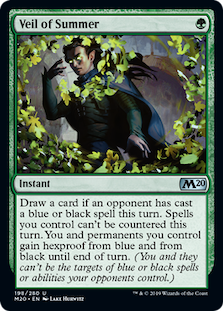 primary threat is recursive and benefits from attrition, they've got a lot of counters for opposing answers, and they certainly don't lack card advantage. It's hard to gain advantage maindeck, and then it gets worse after sideboard, when UGx brings in additional counters and Veil of Summer to defeat the typical anti-control strategy of discard and counters.
primary threat is recursive and benefits from attrition, they've got a lot of counters for opposing answers, and they certainly don't lack card advantage. It's hard to gain advantage maindeck, and then it gets worse after sideboard, when UGx brings in additional counters and Veil of Summer to defeat the typical anti-control strategy of discard and counters.
Jeskai sidesteps this problem by running cheap red and white answers. In a sense, Jeskai's running a maindeck counterboard strategy against UGx. It gets deeper when options like Teferi, Time Raveler and Spell Queller are in the mix. As a plus, Lightning Bolt is good at trading for the Coatls, Snapcaster Mages, and Emrys that fill out UGx decks. The problem has been actually wielding that advantage.
Jeskai Ascending?
I've tried a number of different decks and so far, and going for a counter-light, board-control-focused tempo deck has worked best against UGx. It's easier to dodge the typical sideboard cards and spread their relevant answers when all the answers are one-mana. Also, UGx assumes that their overpowered threats will hide their lack of hard answers beside counters, which gives Jeskai's cheap answers an opening. I would not recommend this decklist for a tournament, but as a proof of concept, it has worked beautifully.
Jeskai Tempo, Test Deck
Testing has borne out my initial suspicions. First, the Triomes are as good as anticipated and are a fine replacement for Celestial Colonnade. Secondly, the matchup has worked as I expected. UGx midrange decks struggle against the more mana-efficient answers from Jeskai and their sideboards are poorly prepared for the fight. Resolving Path to Exile on Uro, Titan of Nature's Wrath is surprisingly backbreaking, while riding a Teferi is less-surprisingly backbreaking.
The issue has been making it all come together consistently. Jeskai can't make up for any missteps or inefficiencies with cantrips like UGx, making the margins tighter than a metagame deck should have. The principle works and there's margin to be gained here, but I'm not there yet.
The Dreamers
The other big talking point are the companions. As Jordan covered in detail Tuesday, they read as an attempt to bring Commander gameplay to Modern. A copy in your sideboard can be declared as a companion and played from outside the game once. Which really just means bringing it into the game, similar to a wish. Thus, companions are extra cards in exchange for a sideboard slot and deckbuilding restrictions. The cost/benefit of giving up a sideboard slot is hard to evaluate. Players have asked for more sideboard slots before, so slots are valuable. I don't know how to evaluate if they're more valuable than an extra card functionally in hand.
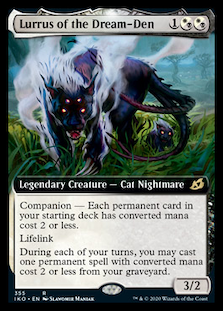 While some had been spoiled when I was writing last week, I dismissed them. Keruga, the Macrosage could only see play as a win-more card in Living End, while Lutri, the Spellchaser makes decks inefficient. The idea was interesting, but didn't seem playable.
While some had been spoiled when I was writing last week, I dismissed them. Keruga, the Macrosage could only see play as a win-more card in Living End, while Lutri, the Spellchaser makes decks inefficient. The idea was interesting, but didn't seem playable.
Then, Lurrus of the Dream-Den was spoiled. Suddenly, this mechanic looked actually playable. Kaheera, the Orphanguard was spoiled at about the same time, but I'm not concerned. While Elementals is already a deck, it's not very good, and adding a semi-tutorable lord isn't changing things. Lurrus on the other hand looked potentially busted. Modern mana costs tend to be low-to-the-ground as is, and so it seemed like Lurrus would just go everywhere. Having more cards is always going to be better than fewer, and thus Lurrus would spread throughout the format.
Abrupt Awakening
Or at least, that's what I thought. Then I actually starting looking through decklists and trying to make Lurrus happen. As it turns out, Lurrus is a much harder fit than expected. As in, it didn't really fit anywhere without a lot of work. Work that was increasingly hard to justify.
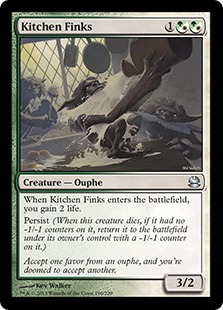 Most Modern decks rely on 3 CMC or greater permanents, from planeswalkers to value engines and combo pieces. To the point that they're not easily replaced, and even when it's possible, it isn't necessarily desirable. My initial thought was that Lurrus fit into Collected Company combo quite competently. Devoted Company was already just mana dorks and two-drops, I thought. It should house Lurrus without any problems and I could write a nice, easy section about giving the fragile combo deck a grinding plan.
Most Modern decks rely on 3 CMC or greater permanents, from planeswalkers to value engines and combo pieces. To the point that they're not easily replaced, and even when it's possible, it isn't necessarily desirable. My initial thought was that Lurrus fit into Collected Company combo quite competently. Devoted Company was already just mana dorks and two-drops, I thought. It should house Lurrus without any problems and I could write a nice, easy section about giving the fragile combo deck a grinding plan.
However, upon bothering to actually check Company decklists, I was reminded that the most popular version requires Heliod, Sun-Crowned. Which was very annoying, as I'd discussed this deck recently and should have known better. They're also leaning heavily on Ranger-Captain of Eos. Thinking that I was confusing Heliod Company with an earlier iteration, I did a deck search.
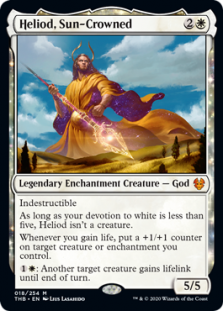 It turned out there had never actually been a time when Company's combos or value creature plan was all two-drops or cheaper. Early Devoted Company decks were close, but they always had at least a few Eternal Witnesses or Shalai, Voice of All, and later versions often had Kitchen Finks.
It turned out there had never actually been a time when Company's combos or value creature plan was all two-drops or cheaper. Early Devoted Company decks were close, but they always had at least a few Eternal Witnesses or Shalai, Voice of All, and later versions often had Kitchen Finks.
This means that for Lurrus to be Company's companion would require a deck redesign. Frankly, I don't think anyone will be taking apart Heliod Company for Lurrus. The combo potential and tutoring of Ranger-Captain is too good to cut, even for an eighth card in hand. Straight Devoted Company from past years could do it more easily, but over their lifetimes, those decks started moving up the curve. Finks and Witness are really good cards, apparently. It turns out that Lurrus's opportunity cost of companionship is not just a sideboard slot, but multiple maindeck ones, as well. As a result, I don't think Lurrus will see play in Company decks because lowering the curve is not desirable.
Fleeting Dreams
So, where does Lurrus belong? After an exhaustive look through upper tier decks, I conclude: nowhere. There are low-tier Zoo-type decks that can absolutely run Lurrus right now, but the top decks are filled with three cost creatures and/or planeswalkers. I was on the same wavelength as Jordan and next went to Traverse Shadow, also thinking that it just entailed replacing Liliana of the Veil with Kroxa, Titan of Death's Hunger. Then I had another 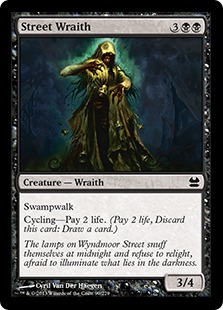 awkward duh moment seeing Street Wraith. Which, despite being used as such, is not actually a Phyrexian mana cantrip but a five-mana creature. And is rather integral to the strategy. Which means Lurrus was out and it was time to move on.
awkward duh moment seeing Street Wraith. Which, despite being used as such, is not actually a Phyrexian mana cantrip but a five-mana creature. And is rather integral to the strategy. Which means Lurrus was out and it was time to move on.
However, after several hours combing databases, the only decks that consistently met the companion requirement were Burn and Infect. It turns out that 3-drop permanents are surprisingly common. Infect was right out since almost every decklist I saw was straight Simic. The white splash is being dropped, and Lurrus isn't a strong enough reason to start stretching again. Meanwhile, Burn could run Lurrus, but why would it want to? It's expensive by Burn standards, and doesn't have haste. Also, white is more of a splash, which can make double white tricky. And Burn's version of grinding is throwing fire to the face. Thus, Lurrus is not a natural fit in Burn. It could happen if Burn really needs the extra card. But again, does Burn really want it?
Reframing the Dream
However, that may not be it for companions. As Jordan noted, Zirda, the Dawnwalker has a relevant static ability and fits into decks already. The catch is that, again, there's not much reason to do so outside of having a companion. Temur Urza decks draw enough cards that I don't think an eighth is really necessary. It will only hurt if the value of another threat is lower than the missing sideboard card, which I can't really evaluate.
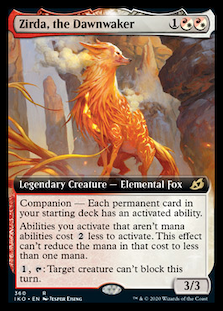 As for actually building with Zirda, Company decks aren't making it easy. On the one hand, Zirda doesn't fit in Company any better than Lurrus. Again, a lot of the combos need creatures without activated abilities. These range from Vizier of Remedies to Kitchen Finks. The only combo which is only activated abilities is Heliod and Walking Ballista. Company could pare down to that combo, but that's not what Company players have signed on for, so probably not happening. Company also ruined any chance of making a deck that actually wanted Zirda by being more efficient. Every permanent based combo or even value deck I tried was just a worse version of Company.
As for actually building with Zirda, Company decks aren't making it easy. On the one hand, Zirda doesn't fit in Company any better than Lurrus. Again, a lot of the combos need creatures without activated abilities. These range from Vizier of Remedies to Kitchen Finks. The only combo which is only activated abilities is Heliod and Walking Ballista. Company could pare down to that combo, but that's not what Company players have signed on for, so probably not happening. Company also ruined any chance of making a deck that actually wanted Zirda by being more efficient. Every permanent based combo or even value deck I tried was just a worse version of Company.
Ultimately, I have to conclude that the only real appeal of the companion cards is the opportunity to have a guaranteed extra card every game. However, actually building decks that make it happen is harder than I thought. Decks could be built around them, but if these decks weren't good enough on their own before the companions, I'm skeptical they would be now. Subsequently, and in defiance of Zvi Moshowitz and Sam Black, I'm doubtful that they'll see much play in Modern.
Tread Quietly
There's still a lot of work to be done on the new cards, and its possible there's something I missed or that dedicated shells will make the companions shine. Which Ikoria cards have you the most excited? Have our readers experienced any luck brewing around the companions? Let us know in the comments!




Jeez, I’m behind on my Modern Nexus reading!!! David what do you think of Sea-Dasher Octopus as a two-of in something like Spirits or Merfolk where the creatures are naturally evasive and get a protective buff Frome things like Drogskol or Kira?
It’s an interesting thought, but something of a gimmick. If you want that effect in those decks, Curious Obsession already exits and is better most of the time.
That said, I’ve been toying with the Octopus as a means around the legend rule for taxes decks. Turning Thalia into an octopus gives an extra point of toughness but more importantly lets you play the Thalia rotting in your hand and really put the screws on. It’s been fun if only a bit gimmicky.
Welcome back Dan!